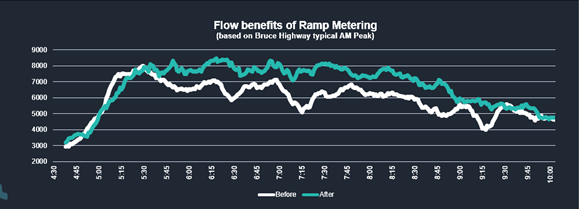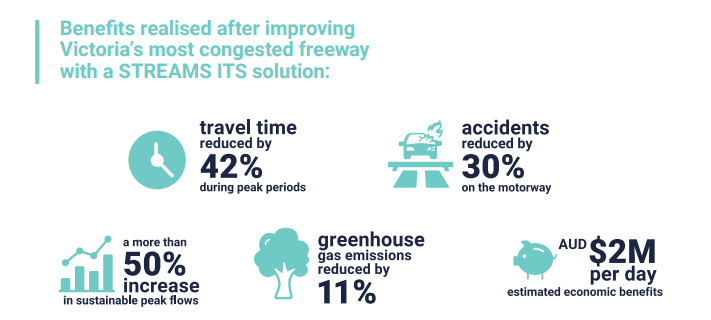How does coordinated ramp metering technology work?
Ramp meters are traffic signals installed on freeway on-ramps to control the frequency at which vehicles enter the flow of traffic on the freeway. Ramp signals work like normal traffic lights, only faster, allowing a certain number of vehicles at a time to enter the freeway.
Ramp metering can be a valuable tool for efficient traffic management on freeways and freeway networks. Ramp metering aims to make better use of existing freeway capacity, helping to improve traffic flow and reduce congestion. This often removes the need to build costly new infrastructure such as additional lanes.
- STREAMS continuously monitors traffic conditions through vehicle detectors located at regular intervals on a freeway and freeway ramps.
- Real-time data from each detection location is consolidated and communicated to the STREAMS integrated control platform.
- Data is then processed using advanced traffic management algorithms to identify changes in traffic flows and determine ramp metering rates (the timing of the ramp signals), giving vehicles joining the freeway time to merge safely.
Freeways often operate significantly below their intended capacity during peak periods.
Ramp metering prevents flow loss triggered by oversaturated conditions – thus allowing the freeway to run at its design capacity.
In Queensland, Australia, Southbound traffic on the Bruce Highway between the Gateway Motorway and Caboolture was highly congested during weekday morning peak periods. As part of the Bruce Highway managed motorway project, ramp metering signals were installed on five on-ramps. The ramps were configured to implement the STREAMS Smart Motorways ramp metering algorithm.
A study by the ARRB Group analysed the performance of the ramp metering solution on the Bruce Highway by calculating the cost of congestion as expressed in average daily vehicle-kilometres travelled (VKT). The study found that the daily congestion cost was reduced by 26% on a typical weekday. The bulk of these cost savings originated from reduced excessive delay cost, which experienced a 39% reduction. In addition, the travel time reliability cost dropped by 7%. Additionally, the study noted that, when normalising by VKT to control for the effects of natural traffic growth over time, more significant cost savings were identified, especially during morning peak when ramp metering was active. Reductions per 1,000 VKT were total congestion (30%), excessive delay (42%) and reliability costs (12%) during morning peak.
These cost savings translate to reduced daily congestion, delay and an increase in travel reliability and flow.

In Melbourne, Victoria, a study found that the use of coordinated ramp metering resulted in greater mobility, with travel time reduced by 42% during peak periods (2010 study). In addition, economic benefits were estimated at $2 million per day, along with reduced fuel consumptions and costs.

STREAMS Smart Motorways uses the world-leading ALINEA HERO algorithm in a years-long collaboration with the Technical University of Crete.
The solution uses four main mechanisms to manage motorway traffic:
- Breaking up platoons arriving from the arterial network.
- Adjusting the entry flows based on the capacity of the motorway.
- Finding the moving bottleneck locations and calculates their dynamic capacity.
- Balancing the workload and queue across all the available ramps.
ALINEA HERO is a proven solution in improving motorway congestion. Many existing or traditional ramp metering systems only apply the first or second mechanism and therefore aren’t able to produce the same outcomes or benefits in regard to maximising freeway performance and reducing congestion.
Transmax undergoes rigorous analysis to identify where best to measure data and place detectors to optimise the technology and motorway capacity. STREAMS also utilises enhanced calculations to measure motorway data to make meaningful observations, which in turns helps to optimise the route or segment.
Coordinated ramp metering takes an overall view of the entire freeway to identify and manage traffic conditions to ensure traffic keeps flowing. The system manages bottlenecks (localised disruption of traffic on a freeway) across the whole freeway and not just near an individual ramp. Operating this way improves traffic conditions in areas a driver cannot see and enables a more optimised journey across the freeway network.
Just one ramp not being controlled can impact traffic flow and cause congestion. Effective control of the whole freeway requires all ramps to be controlled so that vehicles entering the freeway are being managed within the total capacity of the entire freeway.
Coordinated ramp metering is about managing bottlenecks along the whole motorway, not just near a ramp. This system takes a big-picture view to identify all areas where traffic conditions need to be managed to keep traffic flowing, i.e., to provide benefits in areas that the driver cannot see.
Just one uncontrolled ramp can cause flow breakdown and congestion, effective control requires all ramps to be controlled to ensure that entering traffic is managed within the overall capacity of the motorway system.
STREAM Smart Motorways uses sophisticated ALINEA HERO ramp metering algorithms to control and coordinate all entry ramps along a route to manage the mainline freeway at a number of critical bottleneck locations. This ensures traffic flow is evenly distributed into the mainline.
- ALINEA manages local metering to fix congestion near the on ramp
- HERO balances equity of access and demand across the network
The system is based on the latest traffic flow science to provide stable and reliable travel that optimises traffic throughput and travel speed along the whole freeway (not just at ramp merges).
Using ramp signals to break up the bunching of vehicles on a ramp makes it easier to merge. This helps traffic enter the motorway. In addition, operating the ramp signals as a coordinated system assists in limiting excess traffic arriving at downstream bottlenecks some distance away. Coordinated ramp signals provide wider benefits for overall motorway performance.
Coordinated ramp signals also help to speed up the recovery of the motorway after breakdown.
Ramp metering aims to get the road back to working at its design capacity, allowing vehicles to flow through the motorway at its intended volume. A well-designed and operated system will maintain flow and improve safety. Ramp metering manages the amount of traffic in the merge area to maintain stable flow conditions, particularly when the motorway is near capacity.
Even when congestion does occur, measured outcomes show that continuing to meter traffic still results in better flows than if they were switched off.
A small delay shared across a number of ramps prevents a significant delay later on, resulting in more reliable freeway journeys, shorter travel times and more vehicles getting through the motorway. This is because:
- When freeways become congested, less traffic gets through, delays for all motorists increase significantly and fewer vehicles are able to enter the system.
- Excessive ramp queues are usually a result of traffic breakdown due to large increases in vehicles trying to use the freeway Ramp metering tries to help the freeway recover to stable flow while also managing ramp queues.
- When freeway flows are maintained without breaking down, more vehicles can enter, increasing ramp flows, even when metering is in operation.
- Events (such as accidents or a change in weather) that lead to flow breakdown can occur very quickly (often in less than a minute) - instability may also occur at relatively moderate flows.
- There may be a need to manage a traffic problem further downstream from the metered ramp and nearby merge.
How will my journey be easier?
- improved road safety, due to more stable motorway travel with less stop-start conditions
- a more reliable service
- reduced overall trip times due to improved travel speed
- minimisation of flow breakdown and congestion
- increased motorway throughput
Freeway to freeway ramp metering
Traffic management equipment is usually placed upstream of F2F ramps in order to warn motorists to slow down before they reach the queue. Signs, beacons, and even Variable Speed Limit (VSL) signs slow the traffic before the ramp signals, if they are active.
These traffic signals help space out vehicles, making merging safer and faster, resulting in less congestion and fewer collisions.
Impacts on Arterials
Freeways managed with coordinated ramp metering help to achieve higher sustainable motorway flows, showing benefits for the broader arterial road network.
If a motorway can carry more traffic in the peak periods, the operation of arterial roads (non-motorway roads) will also be more efficient.
- The particular ramp will recruit other upstream ramps to help manage the flow across the network.
- The ramp will put “upward pressure” on the metering rate proportionate to the size of the queue, allowing vehicles to enter the motorway more quickly while maintaining flow across the motorway.
- If the ramp becomes completely full, the maximum metering rate will automatically be applied to reduce the queue on the ramp.
Where the wait time is too high, the system can also put “upward pressure” on the metering rate.
The system aims to manage queues in a safe and regulated manner within the ramp length, discharging traffic without exceeding motorway capacity. Balancing of queues and waiting times are also used across the coordinated ramps.
What do I need to do? (Using coordinated ramp signals)
The traffic signals at motorways allow one car per lane when the signal is green. Unlike regular traffic signals, the interval between red and green is much shorter. Be sure to stop as usual at the red light and go when the light turns green.
Ramp signals do not keep to a fixed time and the cycle can change very quickly. When traffic flow along the motorway is high, you may need to wait longer before entering that motorway.
Once you’ve passed the ramp signals, you can speed up as you merge onto the motorway.
Ramp metering signals are road safety devices and motorists must stop on the red signal and then wait for a green light. Drivers need to travel at an appropriate speed when using the ramp for the safety of all traffic.
All you need to do is follow the signals. Go when the light is green and stop on red. Ramp signals may not have an amber light to transition between the two.
Still have questions?
Ask the Transmax STREAMS Smart Motorways team by emailing us at
smartmotorways-support@transmax.com.au© Copyright 2021 Transmax Pty Ltd. | All Rights Reserved




